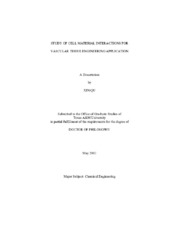| dc.description.abstract | In the US alone, more than 500,000 coronary artery bypass procedures are performed annually. Tissue engineering shows the potential to construct functional grafts to overcome the limited availability of autologous saphenous veins, relatively poor elasticity and low compliance of synthetic materials (mainly Dacron and polytetrafluoroethylene).
In order to meet the low modulus associate with myocyte differentiation, the high suture retention and an ultimate tensile strength (UTS) sufficient to withstand implantation and peak physiological stresses, we designed and characterized a multi-component scaffold comprised of polyurethane electrospun mesh layers bonded together by a fibrin hydrogel matrix. We have demonstrated this composite construct retains the high tensile strength and suture retention strength but displays a "J-shaped" mechanical response similar to that of native coronary artery.
To improve our design, poly(ethylene glycol) diacrylate based hydrogel system was utilized as a blank slate to study the phenotypic regulation by cell material interactions. Fibrinogen, fibronectin, laminin and collagen type IV were incorporated into the hydrogel to mimic the stimuli from extracellular matrix (ECM) proteins. Surprisingly, no significant effect was detected on induction of smooth muscle cell (SMC) differentiation marker expression, activation of mitogen-activated protein (MAP) kinases pathway, or alteration of surface integrin expression profile. However, fibronectin showed repression of undesired phenotypes in SMC differentiation.
In contrast to ECM proteins, glycosaminoglycans (GAGs) showed more influence on regulating SMC phenotype. By using a scaffold environment intended to be mimetic of early atherosclerosis, the impact of GAG identity on SMC foam cell formation was explored. We focused on chondroitin sulfate C (CSC), dermatan sulfate (DS), and an intermediate molecular weight hyaluronan (HA_IMW, ~400 kDa), the levels and/or distribution of which are significantly altered in atherosclerosis. CSC and DS hydrogels were associated with greater SMC phagocytosis of apolipoprotein B than HA_IMW gels. However, only SMCs in DS constructs maintained increased expression of adipocyte marker A-FABP relative to HA_IMW gels over 35 days of culture.
Combined, our results suggested interesting roles for fibronectin and HA_IMW in repression of undesired phenotypes in SMC differentiation, which could give insights into rational design of novel biomaterials for vascular tissue engineering applications. | en |


